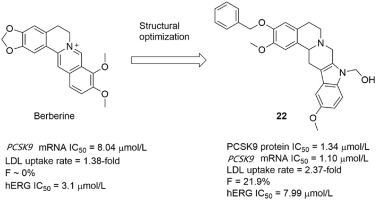当前位置:
X-MOL 学术
›
Acta Pharm. Sin. B
›
论文详情
Our official English website, www.x-mol.net, welcomes your feedback! (Note: you will need to create a separate account there.)
Design, synthesis, and biological evaluation of novel tetrahydroprotoberberine derivatives (THPBs) as proprotein convertase subtilisin/kexin type 9 (PCSK9) modulators for the treatment of hyperlipidemia.
Acta Pharmaceutica Sinica B ( IF 14.7 ) Pub Date : 2019-06-25 , DOI: 10.1016/j.apsb.2019.06.006 Chenglin Wu 1, 2 , Cong Xi 1, 3 , Junhua Tong 1, 3 , Jing Zhao 1, 3 , Hualiang Jiang 1, 3 , Jiang Wang 1, 3 , Yiping Wang 1, 3 , Hong Liu 1, 3
Acta Pharmaceutica Sinica B ( IF 14.7 ) Pub Date : 2019-06-25 , DOI: 10.1016/j.apsb.2019.06.006 Chenglin Wu 1, 2 , Cong Xi 1, 3 , Junhua Tong 1, 3 , Jing Zhao 1, 3 , Hualiang Jiang 1, 3 , Jiang Wang 1, 3 , Yiping Wang 1, 3 , Hong Liu 1, 3
Affiliation

|
Proprotein convertase subtilisin/kexin type 9 (PCSK9) modulators may attenuate PCSK9-induced low-density lipoprotein receptor (LDLR) degradation in lysosome and promote the clearance of circulating low-density lipoprotein cholesterol (LDL-C). A novel series of tetrahydroprotoberberine derivatives (THPBs) were designed, synthesized, and evaluated as PCSK9 modulators for the treatment of hyperlipidemia. Among them, eight compounds exhibited excellent activities in downregulating hepatic PCSK9 expression better than berberine in HepG2 cells. In addition, five compounds 15, 18, 22, (R)-22, and (S)-22 showed better performance in the low-density lipoprotein, labeled with 1,1'-dioctadecyl-3,3,3',3'-tetramethyl-indocarbocyanine perchlorate (DiI-LDL) uptake assay, compared with berberine at the same concentration. Compound 22, selected for in vivo evaluation, demonstrated significant reductions of total cholesterol (TC) and LDL-C in hyperlipidemic hamsters with a good pharmacokinetic profile. Further exploring of the lipid-lowering mechanism showed that compound 22 promoted hepatic LDLR expression in a dose-dependent manner in HepG2 cells. Additional results of human ether-à-go-go related gene (hERG) inhibition assay indicated the potential druggability for compound 22, which is a promising lead compound for the development of PCSK9 modulator for the treatment of hyperlipidemia.
中文翻译:

设计,合成和生物学评估新型四氢小pro碱衍生物(THPBs)作为前蛋白转化酶枯草杆菌蛋白酶/ kexin 9型(PCSK9)调节剂,用于治疗高脂血症。
原蛋白转化酶枯草杆菌蛋白酶/ kexin 9型(PCSK9)调节剂可减弱PCSK9诱导的溶酶体中低密度脂蛋白受体(LDLR)降解并促进清除循环中的低密度脂蛋白胆固醇(LDL-C)。设计,合成和评估了一系列新颖的四氢原小ber碱衍生物(THPBs),作为PCSK9调节剂用于高脂血症的治疗。其中,在HepG2细胞中,有8种化合物比小ber碱具有更好的下调肝PCSK9表达的优异活性。此外,五种化合物15、18、22,(R)-22和(S)-22在低密度脂蛋白中表现出更好的性能,用1,1'-二十八烷基-3,3,3',3标记与相同浓度的小ber碱比较,'-四甲基-吲哚羰花青高氯酸盐(DiI-LDL)吸收测定法。化合物22 选择用于体内评估的结果表明,具有良好药代动力学特征的高脂血症仓鼠中的总胆固醇(TC)和LDL-C显着降低。进一步的降脂机理研究表明,化合物22在HepG2细胞中以剂量依赖的方式促进了肝脏LDLR的表达。人源-去-源-相关基因(hERG)抑制试验的其他结果表明化合物22的潜在药物作用,该化合物是开发用于治疗高脂血症的PCSK9调节剂的有前途的先导化合物。进一步的降脂机理研究表明,化合物22在HepG2细胞中以剂量依赖的方式促进了肝脏LDLR的表达。人源-去-源-相关基因(hERG)抑制试验的其他结果表明化合物22的潜在药物作用,该化合物是开发用于治疗高脂血症的PCSK9调节剂的有前途的先导化合物。进一步的降脂机理研究表明,化合物22在HepG2细胞中以剂量依赖的方式促进了肝脏LDLR的表达。人源-去-源-相关基因(hERG)抑制试验的其他结果表明化合物22的潜在药物作用,该化合物是开发用于治疗高脂血症的PCSK9调节剂的有前途的先导化合物。
更新日期:2019-09-09
中文翻译:

设计,合成和生物学评估新型四氢小pro碱衍生物(THPBs)作为前蛋白转化酶枯草杆菌蛋白酶/ kexin 9型(PCSK9)调节剂,用于治疗高脂血症。
原蛋白转化酶枯草杆菌蛋白酶/ kexin 9型(PCSK9)调节剂可减弱PCSK9诱导的溶酶体中低密度脂蛋白受体(LDLR)降解并促进清除循环中的低密度脂蛋白胆固醇(LDL-C)。设计,合成和评估了一系列新颖的四氢原小ber碱衍生物(THPBs),作为PCSK9调节剂用于高脂血症的治疗。其中,在HepG2细胞中,有8种化合物比小ber碱具有更好的下调肝PCSK9表达的优异活性。此外,五种化合物15、18、22,(R)-22和(S)-22在低密度脂蛋白中表现出更好的性能,用1,1'-二十八烷基-3,3,3',3标记与相同浓度的小ber碱比较,'-四甲基-吲哚羰花青高氯酸盐(DiI-LDL)吸收测定法。化合物22 选择用于体内评估的结果表明,具有良好药代动力学特征的高脂血症仓鼠中的总胆固醇(TC)和LDL-C显着降低。进一步的降脂机理研究表明,化合物22在HepG2细胞中以剂量依赖的方式促进了肝脏LDLR的表达。人源-去-源-相关基因(hERG)抑制试验的其他结果表明化合物22的潜在药物作用,该化合物是开发用于治疗高脂血症的PCSK9调节剂的有前途的先导化合物。进一步的降脂机理研究表明,化合物22在HepG2细胞中以剂量依赖的方式促进了肝脏LDLR的表达。人源-去-源-相关基因(hERG)抑制试验的其他结果表明化合物22的潜在药物作用,该化合物是开发用于治疗高脂血症的PCSK9调节剂的有前途的先导化合物。进一步的降脂机理研究表明,化合物22在HepG2细胞中以剂量依赖的方式促进了肝脏LDLR的表达。人源-去-源-相关基因(hERG)抑制试验的其他结果表明化合物22的潜在药物作用,该化合物是开发用于治疗高脂血症的PCSK9调节剂的有前途的先导化合物。












































 京公网安备 11010802027423号
京公网安备 11010802027423号